|
|
|
|
 |
|
 |
| |
|
發行人:吳育任所長 編輯委員:曾雪峰教授 主編:林筱文 發行日期:2025.02.28
|
| |
|
 |
|
本所3月份演講公告:
| 日期 |
講者 |
講題 |
地點 |
時間 |
| 3/7 |
黃耀緯教授
國立陽明交通大學光電工程學系 |
超穎介面於深度感知的應用 |
博理館
101演講廳 |
14:20~16:00 |
| 3/14 |
孫涵瑛教授
中山醫學大學視光學系 |
臨床驗光步驟與原理 |
博理館
101演講廳 |
14:20~16:00 |
| 3/21 |
黃英原教授
國立成功大學電機工程學系 |
新世代太陽光電科技
New Generation Photovoltaic Technologies |
博理館
101演講廳 |
14:20~16:00 |
| 3/28 |
張雍教授
中原大學化學工程學系 |
Bio-inspired Technology: Research, Development, and Commercialization |
博理館
101演講廳 |
14:20~16:00 |
|
|
|
|

|
|

|
|
| |
|
|

|
|
~ 第十三屆亞洲超快現象國際會議 ~
(時間:114年1月5日至8日;地點:臺灣大學學新館)
花絮整理:王鵬瑞
由國立臺灣大學光電工程學研究所孫啟光教授主辦的「第十三屆亞洲超快現象國際會議(13th Asian Conference on Ultrafast Phenomena, ACUP 2025)」已於2025年1月5日至1月8日假國立臺灣大學學新館二樓的SPACE M會議空間圓滿舉行。本次會議為期四天,吸引來自世界各地超過100位專家學者與會,其中包含來自美國、日本、德國、韓國、新加坡等地的34名外籍學者,發表論文總計達70篇,涵蓋邀請演講、口頭報告及壁報論文展示。
亞洲超快現象國際會議自1999年於韓國首次舉辦,每兩年一度,已成為亞洲地區超快現象研究領域的重要學術交流平台。本次大會由孫啟光教授擔任主席,研討主題包含超快光譜學、材料動力學、生物與化學系統中的超快過程、高次諧波與阿秒科學、表面與界面動力學等前瞻研究領域。會議不僅促進亞洲及全球學者之間的交流與合作,也讓國際社群深入了解臺灣在超快現象研究上的最新進展。
1月5日下午,大會開放學者報到註冊,並於當日晚間舉行小型迎賓晚宴,讓與會學者在輕鬆氛圍下進行交流。1月6日上午,大會正式開幕,孫啟光教授於開幕典禮中致詞,強調亞洲國家在超快現象研究上的重要性,並期許透過本次會議深化國際合作,促進學術創新。
此次會議共安排41場口頭報告,其中包含多位國際知名學者的邀請演講,例如來自日本的Keisuke Tominaga及Akihiro Furube教授、韓國的Dongho Kim教授、新加坡的Howe-Siang Tan教授等。此外,壁報論文展示也安排了兩個專屬時段,讓與會者能夠與發表人進行深入討論,現場討論氣氛熱烈。學術研討之餘,大會亦安排了豐富的文化交流活動。1月7日晚間,大會設宴款待所有註冊與會者,提供臺灣特色美食,促進學者間的社交與學術對話。1月8日下午,與會者參加臺北市文化參訪行程,參觀孔廟、保安宮及鼎泰豐等極具代表性的景點,進一步體驗臺灣文化及飲食之美。
本次會議的成功舉辦,不僅讓國內外學者對臺灣的研究水準留下深刻印象,也為臺灣學術界與國際同行搭建了更多合作的機會。未來,國立臺灣大學將持續舉辦或參與高水準的國際會議,深化國內外學術界的交流,進一步提升臺灣在超快現象領域的學術影響力。
|
|
|
|

|
|

|
|
| |
|
|

|
|
蕭惠心副教授 分別於2007年及2013年,在臺灣大學獲得物理學系學士學位與光電工程學研究所博士學位。博士畢業後,她先後於本校光電所、德國Karlsruhe Institute of Technology、本校物理系及中央研究院應用科學研究中心從事博士後研究。隨後在臺北醫學大學生醫光機電所與臺灣師範大學光電所擔任助理教授及副教授;自2022年8月起加入臺大工程科學及海洋工程學系擔任副教授,並於2025年2月合聘於光電所。
蕭副教授實驗室聚焦於微/奈米光電子元件與超穎介面的研究,主要涵蓋以下幾個方向:
◆
金屬及介電質奈米光學元件:設計與製作各類金屬及介電質奈米結構,應用於高靈敏度感測元件、表面增強拉曼基板,以及二倍頻、三倍頻訊號轉換與材料光學特性調製等非線性光學研究。
◆
中紅外熱輻射發射器:開發針對中紅外波段之窄頻、多波長熱輻射發射器,作為分子光譜檢測系統的光源。
◆
超穎介面與超穎元件:設計超輕薄之寬頻高效率消色差超穎透鏡與多功能極化分光器,開發超穎元件於各領域的應用。
蕭副教授過去曾獲得包括吳健雄獎學金(2014)、博士後研究人員學術著作獎(2015)及科技部補助赴國外從事博士後研究等獎項。任教期間,她於2022年榮獲中華民國光電學會青年光電工程獎,並於2024年成為國科會優秀年輕學者研究計畫得主。
其研究成果發表於《Advanced Science》、《Small Methods》、《Laser and Photonics Reviews》、《Advanced Optical Materials》、《Nanophotonics》、《ACS Applied Nano Materials》等國際頂尖學術期刊,並多次受邀於SPIE Optics + Photonics、META、Metamaterials、SPP、PIERS、APNFO、ICNN等國際重要光學會議上發表受邀演講(invited talks)。
此外,蕭副教授積極參與國內外學術活動,曾擔任《Journal of the Optical Society of America B》期刊「Tunable and dynamic nanophotonics」專題的客座編輯;於2024年及2025年分別擔任美國光學學會OPTICA台灣分會的財務與副會長;自2020年起擔任台灣資訊儲存技術協會(TISA)理事,並於2024年當選為TISA常務理事。蕭副教授過去亦曾服務於中國工程師學會第73屆「女性工程師委員會」、中華民國光電學會教育委員會、台灣物理學會公共事務委員會以及擔任台灣女科技人學會秘書長等。
在教學研究之餘,蕭副教授喜歡球類運動,包括羽球、桌球與排球,假日有時間會前往近郊爬步道、親近大自然,同時也喜歡唱歌紓壓。
蕭副教授認為光電領域融合了光學、電子、材料科學與奈米科技等多學科,並在通訊、能源、顯示技術與生醫工程等領域展現廣泛應用。隨著人工智慧、半導體與綠能技術的快速發展,矽光子學與量子光學日益受到關注;同時,智慧穿戴裝置、生醫影像技術與可再生能源光電技術也正蓬勃發展,將進一步推動產業創新,光電技術的應用也將持續拓展,對具備跨領域專業能力的人才需求勢必與日俱增。
|
|
|
|

|
|

|
|
| |
|
|

|
|
a-IGZO Thin-Film Transistors on Cellulose Nanopaper Substrates
Professor I-Chun Cheng
Graduate Institute of Photonics and Optoelectronics, National Taiwan University
臺灣大學光電所 陳奕君教授
Paper-based electronics offer an environmentally friendly alternative to conventional plastic substrates, with cellulose nanomaterials gaining significant attention for their enhanced surface properties and sustainability. However, such substrates are prone to damage under high temperatures or moisture, limiting their applicability. Common fabrication methods on paper include printing, transfer processes, and shadow-masking, which often compromise precision or scalability. To overcome these challenges, we developed a photolithography-compatible process to fabricate amorphous indium gallium zinc oxide (a-IGZO) thin-film transistors (TFTs) on cellulose nanopaper, paving the way for scalable and flexible green electronics. The process begins with the preparation of a cellulose nanopaper substrate by drop-casting a precursor solution of cellulose nanofibers and cellulose nanocrystals onto a rigid carrier substrate, followed by curing. A protective parylene layer is deposited to shield the substrate from solvents. A multi-layer stack of SiNx, SiO2, and Al2O3 is added to enhance adhesion and act as a contamination barrier. The active a-IGZO channel layer is then deposited via RF sputtering. Source and drain electrodes are formed using e-beam evaporation of Ti and Ni films, and an HfO2 gate insulator is applied through atomic layer deposition. A Ni gate electrode is deposited, and contact holes are patterned via reactive ion etching. The assembly is maintained at temperatures below 150°C and is finally detached from the carrier substrate. The fabricated TFT features a coplanar top-gated structure, as shown in Fig. 1(a). Prior to detachment, the device exhibited a linear field-effect mobility of 5.66 cm²/Vs, a threshold voltage of 5.01 V, a subthreshold swing of 0.706 V/decade, and an on-off current ratio of 6.36 × 10⁷. Output characteristics showed no current crowding, indicating excellent ohmic contacts. Post-detachment, the TFT retained robust performance, with a mobility of 4.23 cm²/Vs, a threshold voltage of 4.35 V, a subthreshold swing of 0.695 V/decade, and an on-off current ratio of 2.17 × 10⁷. These results, illustrated in Fig. 2, confirm that the detachment process minimally impacts device performance, underscoring the viability of cellulose nanopaper as a substrate for green electronics.
|
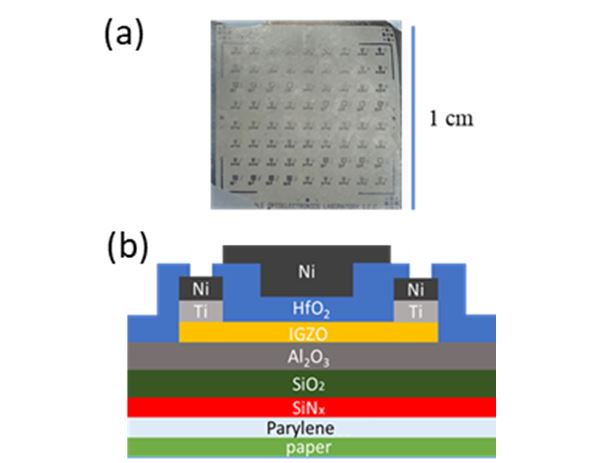
|
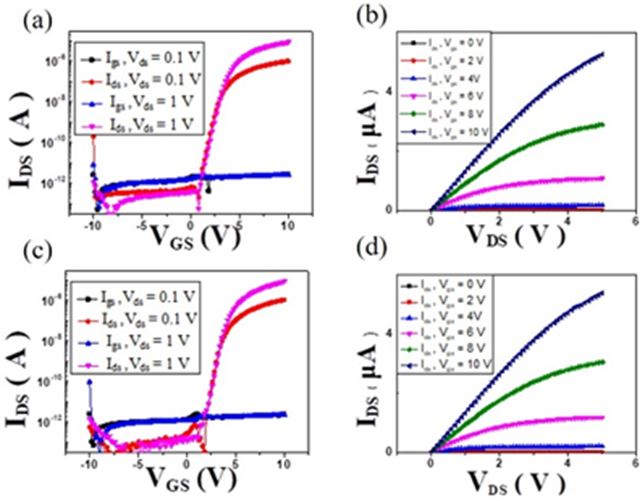
|
|
Fig. 1. (a) Optical micrograph and (b) schematic diagram of a-IGZO TFT on a cellulose nanopaper.
|
Fig. 2. I-V characteristics of a-IGZO TFT on cellulose nanopaper substrate (a)(b) before and (c)(d) after detachment from the carrier substrates.
|
Dual-Axis Mirror Scanner Fabricated with 3D Printing
Professor Jui-che Tsai
Graduate Institute of Photonics and Optoelectronics, National Taiwan University
臺灣大學光電所 蔡睿哲教授
We have demonstrated a low-cost dual-axis mirror scanner of an X-shape architecture. The main structure is 3D-printed with PLA (polylactic acid) as the material. A 20 mm
´
20 mm aluminum-coated silicon chip is attached on the top of the 3D-printed piece and functions as the mirror. Miniature permanent magnets are installed on the back of the mirror, and the mirror can then be actuated by electromagnets. This X-shape scanner reaches 12.2 and 4.6 degrees (optical) for the x- and y-scans at the corresponding resonant frequencies (103 Hz and 128 Hz), respectively.
|
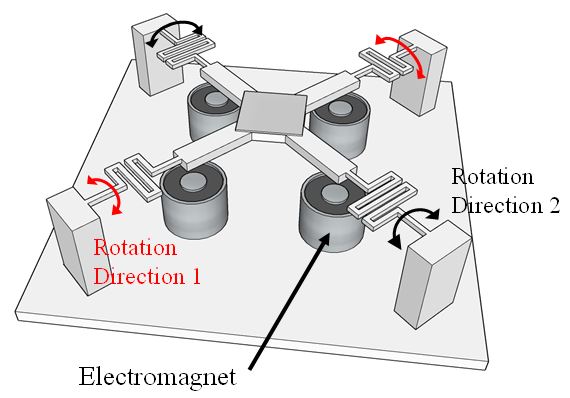
|
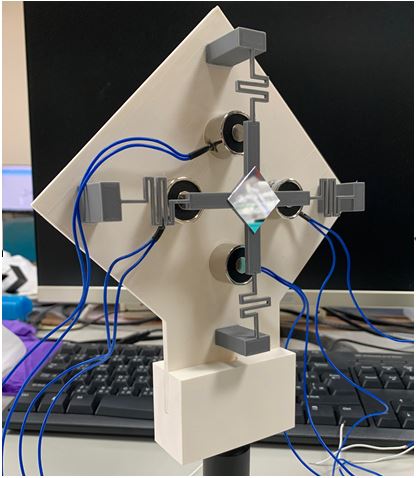
|
|
(a)
|
(b)
|
|
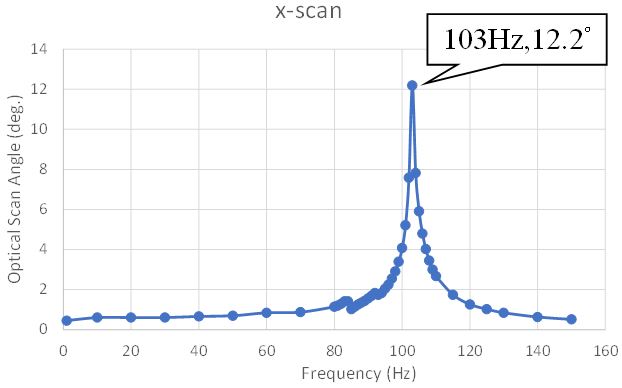
|
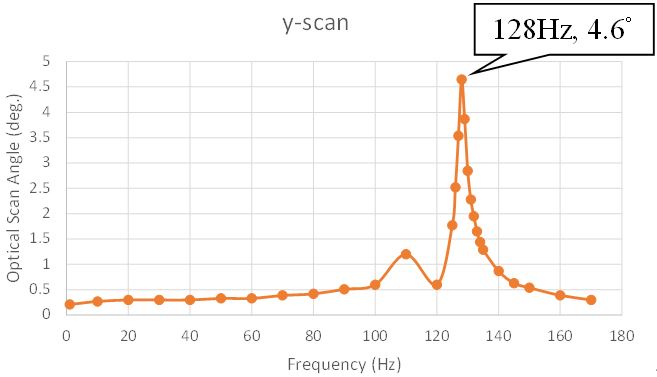
|
|
(c)
|
(d)
|
|
(a) Schematic drawing and (b) photo of the 3D-printed X-shape scanner; frequency responses (optical scan angle vs. driving frequency) of (c) x-direction scanning and (d) y-direction scanning.
|
© SPIE
Yi-Wen Cheng, Wei-An Tsui, Pin-Hung Yeh, Ching-Kai Shen, Jui-che Tsai, “Dual-axis mirror scanners fabricated with 3D printing,” Proc. SPIE 12669, Optomechanical Engineering 2023, 1266905 (28 September 2023)
|
|
|
|

|
|

|
|
| |
|
|

|
|
論文題目:Design and Fabrication of Ultra-High Sensitivity Thermal Sensing Devices Using Light-Emitting Transistors for Smart Technologies
姓名:Mukul Kumar 指導教授:吳肇欣教授
|
摘要
|
|
This dissertation presents a comprehensive study on the design, fabrication, and optimization of Light-Emitting Transistors (LETs) as advanced devices for next-generation smart thermal sensing technologies. LETs, based on III-V compound semiconductors, emerge as innovative, high-speed three-port devices integrating optical and electronic functionalities. Leveraging state-of-the-art quantum-well (QW) structures, LETs demonstrate exceptional potential for high-speed optical communication, enhanced performance in optoelectronic integrated circuits (OEICs), and advanced thermal sensing applications, particularly due to their thermionic emission properties. These findings position LETs as strong candidates for next-generation smart thermal sensing technologies, surpassing traditional thermal sensor technologies in thermal sensitivity.
The study begins with the design and fabrication of single-quantum-well heterojunction bipolar transistors (SQW-HBTs), designed to enhance thermal sensitivity. The innovative incorporation of a staircase QW into the base region of HBTs achieved a 72.23% increase in collector current across a temperature range of 25℃ to 85℃, attributed to faster electron escape dynamics from the QW. A modified charge-control model incorporating thermionic emission theory effectively explains this behavior and provides a foundation for optimizing SQW-HBT structures for thermal sensing applications.
Building on these initial results, the research advances to multi-quantum-well (MQW) and triple-quantum-well (TQW) HBTs to further improve thermal sensitivity. A newly modified charge-control model for MQW-HBTs is developed to account for the influence of quantum-well parameters, such as number and position, on the current gain. This model, validated against experimental results, guides the design of TQW-HBTs, which exhibit a remarkable 200% increase in collector current over the same temperature range and achieving a current sensitivity of 7 μA/℃. These findings highlight the potential of MQW-HBTs such as TQW-HBTs for applications requiring ultra-high thermal sensitivity.
To address the challenges of reduced current due to electron trapping in MQWs, the dissertation introduces a groundbreaking idea developed in the optoelectronics thermal technology by successful design and fabrication of the world’s first Darlington transistor configuration cascaded with LETs. This innovative approach combines the thermionic emission properties of LETs with the amplification benefits of the Darlington design, achieving a 153% increase in LET collector current from 25℃ to 85℃ and a further enhancement to 210% in the Darlington configuration. The collector current-to-temperature sensitivity improves from 8.53 μA/℃ in LETs to 26.2 μA/℃ in the Darlington configuration, with a voltage-to-temperature sensitivity reaching 9.12 mV/℃ surpassing conventional thermal sensor. Despite these advancements, challenges in achieving linear voltage-to-temperature responses are addressed, with recommendations for optimizing QW structures to balance sensitivity and linearity.
Further investigations into the effect of QW width reveal critical trade-offs between thermal sensitivity and linearity. Narrower QWs exhibit higher sensitivity, while wider QWs improve linearity. An optimal QW width of 90 Å achieves a thermal sensitivity of 1.34 mA/℃ at 100°C while maintaining excellent linearity, providing essential insights for designing high-performance thermal sensors. Finally, this dissertation work highlights the transformative potential of LET-based devices, including SQW-HBTs, MQW-HBTs, and TQW-HBTs, for smart thermal sensing applications. The novel configurations, such as the Darlington transistor cascaded with Light-emitting transistor, reported ultra-high thermal sensitivity in this studied. These advancements lay strong ultra-high-thermal performance front-end components for next-generation for smart thermal sensing technologies.
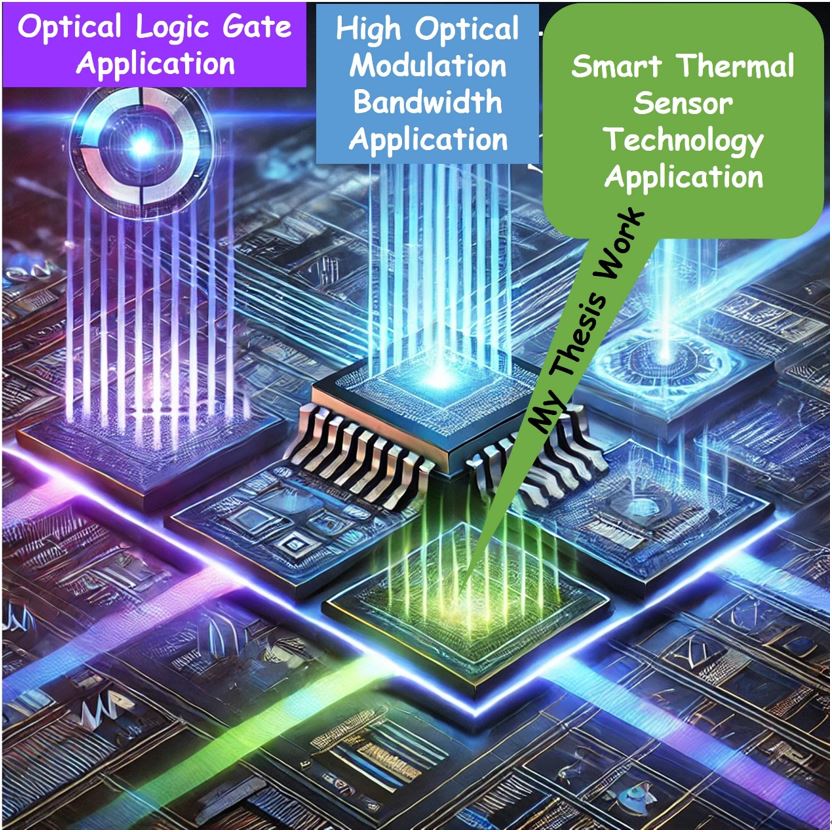 |
|
Fig. 1. Current applications of light-emitting transistors (LETs) and transistor lasers (TLs) include 1) optical logic gates, 2) high optical modulation bandwidth, and 3) smart thermal sensor applications (my thesis work). LETs and TLs are potential candidates for the development of optoelectronic integrated circuits (OEICs).
|
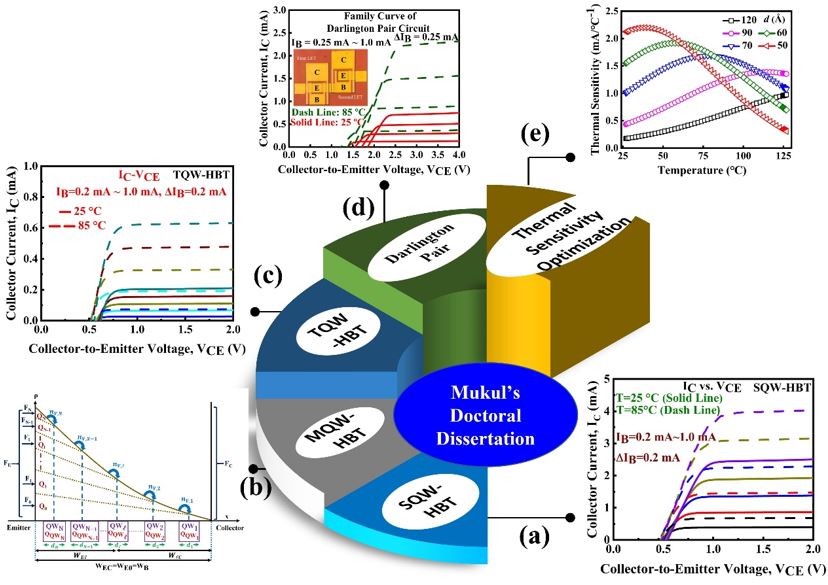 |
|
Fig. 2. (a): IC vs. VCE of n-p-n InGaP/GaAs SQW-HBT at different substrate temperatures. (b) Schematic of minority carrier distribution (ρ) in the base region of an MQW-HBT. (c) IC vs. VCE of n-p-n TQW-HBT at varied IB (0.2 mA to 1 mA), measured at Text=25 ℃ (solid line) and Text=85 ℃ (dashed line). (d) IC vs. VCE at different IB (0.25 mA to 1 mA) at various substrate temperatures. The inset shows the Darlington transistor device contacts and applied bias configuration, with 500 Ω resistance (R) connecting C2 to VDD. (e) Collector current derivation as a function of temperature for varying QW-widths (50 Å, 60 Å, 70 Å, 90 Å, and 120 Å).
|
|
|
|

|
|

|
|
| |
|
|

|
|
— 資料提供:影像顯示科技知識平台 (DTKP, Display Technology Knowledge Platform) —
— 整理:林晃巖教授、郭權鋒 —
磁光增強記憶體運算
非可逆磁光記憶體實現了積體光子平台,支援強大的矩陣向量乘法運算和快速、高效、無疲勞的程式設計能力。
根據國際能源總署(International Energy Agency)的數據,人工智慧計算預計每年將達到460 TWh,到2025年將佔全球電力消耗總量的5%左右。矩陣向量乘法(Matrix-vector multiplication, MVM)運算特別耗能,通常佔AI運算期間消耗的總能量的很大一部分。例如,在GPU上運行的深度學習模型中,MVM操作在訓練和推理期間會消耗約50-80%的總能量。記憶體運算與感測器運算透過實體運算實現了MVM操作的加速。創新硬體物理對於實現MVM操作的高能源效率至關重要。
光子記憶體具有功耗低、運算速度快、平行性高等特性;然而,其受到低積體化密度的限制。此外,實現光學負權重需要一對儲存裝置或一個額外的電開關,而突觸權重由本質上為正的傳輸值表示。磁性記憶體具有超低功耗、優異的循環耐久性和非可逆特性;然而,它的開/關比較低,且多層級狀態有限。
Paolo Pintus、Nathan Youngblood及其同事在《自然光電學》雜誌上發表文章,報導了一種具有非可逆性的磁光儲存單元,可用於光子內存計算。研究人員來自加州大學聖塔芭芭拉分校、卡利亞里大學、匹茲堡大學、日本國家先進工業科學技術研究所(National Institute of Advanced Industrial Science and Technology, AIST)和東京工業大學,他們製作了一個帶有磁光層的矽基環形共振器(silicon micro-ring resonator, SMRR)平台。透過電流脈衝切換整合金電磁鐵的磁化方向和幅度,然後改變每個共振器的波長相關傳輸,可以調制鐵磁性薄膜(Ferromagnetic thin-film, CoFeB)的非揮發性狀態。由於高速磁光響應,晶片上光學處理平台表現出快速(1 ns)、高效能(每單位位元操作143 fJ)和強大(24億次程式設計週期)的可程式性。透過差分操作,非可逆儲存單元已實現了多層儲存,其最大消光比(Extinction Ratio, ER)為16.2 dB(高於MRAM中通常實現的開/關比),從而進一步增強了計算應用中的抗雜訊能力。
Pintus及其同事在SMRR上製作了積體化磁光材料鈰(Cerium)取代釔鐵石榴石(Yttrium iron garnet, Ce:YIG),以實現非可逆磁光。在一個MRR中,來自非可逆光學記憶體的差分傳輸提供MVM操作Wx = b,其中x是編碼在輸入光訊號功率中的輸入數據,W是編碼在相反傳遞模態的差分傳輸中的固定光學權重,而b是透過測量差分光強實現的乘法輸出。光學非可逆性是指光學系統中時間反轉對稱性的破壞,導致兩束非偏振光束沿相同路徑以相反方向傳遞時表現出不同的傳輸特性的現象。磁光材料固有的光學非可逆性確保同一共振腔中的兩種反向傳遞模態具有相反符號的分裂共振相移,導致一個微環形中順時針(Clockwise, CW)和逆時針(Counterclockwise, CCW)傳遞模式的傳輸功率不同(圖1a)。由於CW和CCW模式的傳輸都具有非可逆性,平衡光電探測器測量的差分訊號可實現高度對稱的正負光學權重(圖1b),這對於機器學習應用中的高精度至關重要。磁光共振器不僅透過高對稱非可逆相移實現正負光學權重,而且與相互塞取MRR相比,其結構得到簡化。
|
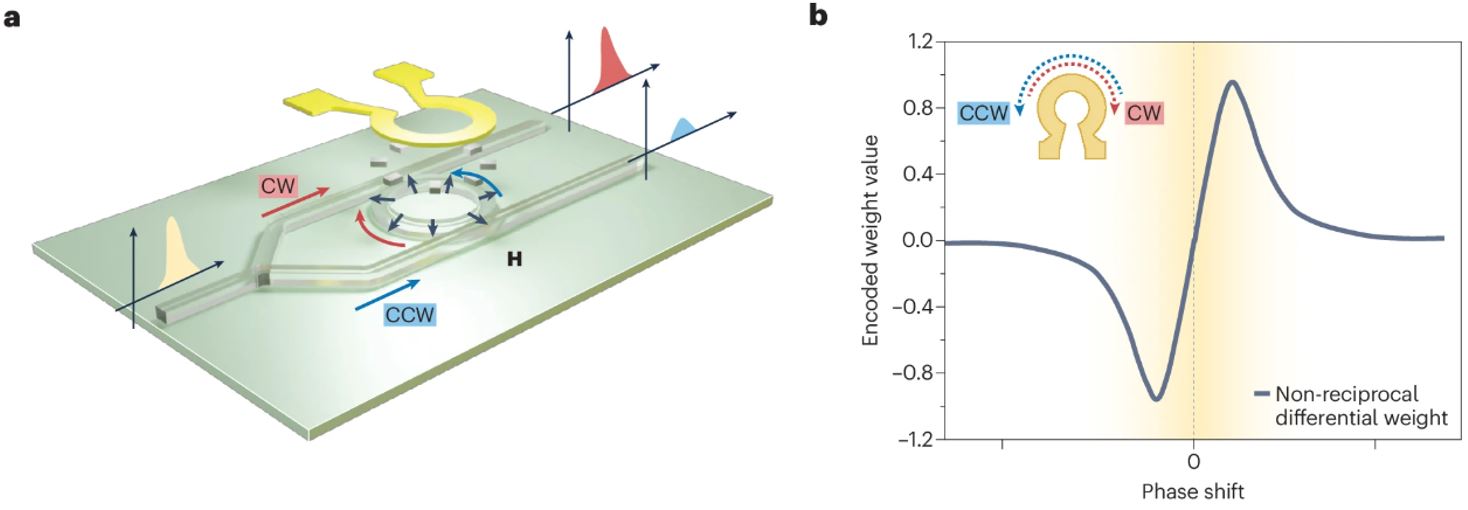
|
|
圖1. a、在非揮發性磁場H下,由於磁光效應,SMRR中CW(順時針)和CCW(逆時針)傳遞模態的差分傳輸。b、透過對CW和CCW模式下的直通連接埠傳輸進行差分運算,對非可逆儲存單元的編碼權重值進行歸一化。
|
在圖2中,展示了非可逆儲存單元與可切換鐵磁層整合時的非揮發性響應。在這個實驗中,圖案化的CoFeB磁條被整合在SMRR上方的包層中,以提供可程式、非揮發性的磁場。微米級CoFeB條形磁鐵的形狀各向異性和方向提供了在儲存單元(24 Memory cell24)中引起非相互光學相移所需的靜態徑向磁場。在本次演示中,SMRR的橫截面為1,000 nm × 220 nm,半徑為50 µm。設備的測量裝置和橫截面如圖2a所示。為了對儲存單元的狀態進行編程,需要將電流施加到整合電磁鐵上,以對CoFeB磁疇中的磁場強度進行編碼。移除電流後,掃描雷射以獲得CW模式的非揮發性MRR光譜偏移(圖2c-e)。對於位於MRR諧振凹陷處的光學探頭(圖2c、d中的虛線),我們觀察到圖2b所示的光學傳輸中的滯後行為。當編程電流從負值增加到正值時,我們觀察到電流大於0 mA時光傳輸的增加(圖2b中的紅點)。由於CoFeB磁層的飽和,傳輸最終會在200 mA以上達到飽和並保持恆定(請參閱圖2a中的圖示)。當我們將施加電流的方向從正值變為負值時,傳輸保持恆定直到負電流值,突出了儲存單元的非揮發性響應。圖5b的結果顯示,至少有11個不同的光傳輸級別,對應於能夠儲存~3.5位元的非揮發性儲存單元;但是,這個值受到我們的實驗設定而不是設備本身的限制。
|
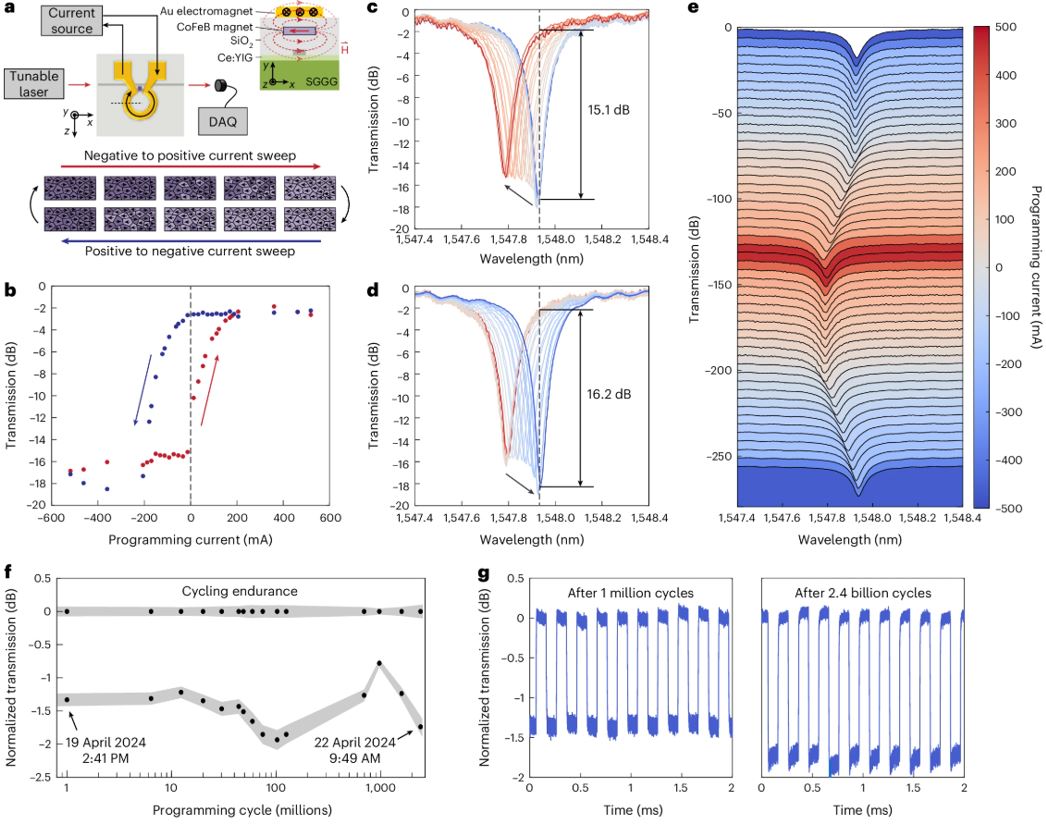
|
|
圖2. a、非揮發性權重編碼的實驗裝置。來自金電磁鐵的磁場根據施加電流的幅度和極性使CoFeB鐵磁層的磁疇排列。b、晶片上整合CoFeB條形磁體的非可逆儲存單元的光傳輸磁滯。對於這些傳輸測量,偵測波長是固定的(c和d中的黑色虛線)。c、從負到正的編程電流掃描顯示正電流出現藍移。d、從正到負的電流掃描顯示回到原始共振位置。e,順序編程電流的透射光譜瀑布圖,首先沿正方向掃描,然後沿負方向掃描。f、經證實具有超過24億次寫入和擦除循環的耐久性。非揮發性寫入和抹寫循環(Erase cycles)的平均值顯示為黑色資料點,而灰色帶表示標準差。g中的時間域測量顯示了儲存單元的運行,沒有觀察到任何效能下降。觀察到的消光比的變化歸因於三天測量中未封裝設備的熱漂移。
|
異質整合磁光於SMRR上使得光學平台與外圍控制電路的整合成為可能,加速了晶片上光子記憶體計算方法的硬體實現。然而,要實現更有效的運算性能還需要進一步發展,這需要改進矽光子整合技術。特別是在記憶體運算的背景下,將整個神經網路完全映射到模擬權重庫所需的大量參數,需要整合多層級狀態的儲存單元和較高的整體整合密度。晶圓接合(Wafer bonding)製程必須考慮製程的兼容性,這可能會限制某些高性能功能材料的使用。在高整合密度的晶片中,磁光記憶體、矽波導等對應功能元件的對準形成了巨大的挑戰。此外,透過非晶矽的生長和圖案化來製造波導等功能元件可以降低SMRR的消光比,從而減少儲存單元中可用的多層級權重狀態的數量。因此,在保持計算性能的關鍵參數(例如磁光系統中的開/關比和位元精度)的同時,改進製造和整合製程至關重要。
在功能方面,大多數光子記憶體計算演示都集中於輸出透射光功率,它是透過將固定波長的輸入光向量與由波長相關的透射共振器單元構成的矩陣相乘而得出的。然而,光向量包含多維資訊(空間、時間、偏振、光譜等),可進一步用於光子運算。在多維MVM計算中,空間、時間、偏振和波長維度上的強度分佈形成輸入向量,而依賴這些維度的傳輸特性則作為光學權重。多維光學處理將使更多的光學資訊在獲取後能夠在感測終端附近同時處理。這種方法增強了光資訊處理的平行性,進一步提高了邊緣運算的整體處理能力。記憶體多維光子運算可以滿足行動裝置、智慧交通、娛樂、安全、工業製造以及醫療和科學系統中各種潛在應用的需求。為了實現多維光學處理,必須開發能夠根據多維資訊編碼權重的可靠光學功能單元。此外,這些光子儲存單元和光互連的高密度整合將是直接多維視覺資訊處理的重要步驟。
|
參考資料: |
Ma, Sijie, Bangsen Ouyang, and Yang Chai, "Magneto-optics enhances in-memory computing," Nature Photonics 19.1 (2025): 9-10.
https://doi.org/10.1038/s41566-024-01599-5
DOI:10.1038/s41566-024-01599-5
|
|
參考文獻: |
Pintus, Paolo, et al, "Integrated non-reciprocal magneto-optics with ultra-high endurance for photonic in-memory computing," Nature Photonics (2024): 1-9.
https://doi.org/10.1038/s41566-024-01549-1
DOI:10.1038/s41566-024-01549-1
|
|
|
|
|

|
|

|
|
|
|
 |
|
 |
|
|
|
|